On July 21, 1861 Confederate forces at Manassas Junction, Virginia beat back and eventually routed the Union army at the First Battle of Bull Run. Here’s a Union participant’s letter to his parents ten days after the battle.
From a Seneca County, New York newspaper (probably) published on August 15, 1861:
From a Seneca Falls Boy in the Battle of Bull’s Run.
The writer of the following letter is the eldest son of Mr. HILDRETH HALSEY of the Town:
Headquarters 38 REGT, CAMP SCOTT, Co. H,
Washington, D.C., July 31, 1861.
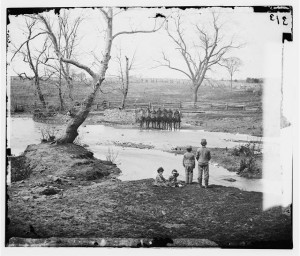
Where the flankers (including Willcox' Brigade) crossed the Run - Sudley Ford (photo March 1862 LOC - LC-DIG-cwpb-00955)
Dear Father and Mother: – I wrote you a few lines Tuesday, on our return from the battle-field, but suppose you have not got them yet. I begin to feel a little like myself now, although I am stiff and sore yet; but will attempt to give you an account of our movements and of the battle, as correct as I can. I will commence at Centreville, from which place we started for the battle-field.
We were all aroused from our slumbers at 12 o’clock on Saturday night and held in readiness until daylight Sunday morning, when we started on the march for Manassas or Bull run, which are in fact all one. We reached there about noon, after marching fifteen miles, and wading muddy streams up to our waists, without having anything to eat since six o’clock Saturday afternoon, save a few hard sea biscuits, which were not very palatable, but had they been ever so good we could not have taken time to eat them.
Just before we entered the field we threw off our blankets, haversacks and jackets, and marched into the field in our shirt sleeves, in a body of five thousand men, which consisted of the whole of the Second Brigade, under command of Col. Wilcox, acting under Brigadier General McDowell. There was only one Regiment on the field before us, and they laid down under the hills, entirely out of sight of the enemy. I believe they fired two shots at random into the woods and then retreated. I do not know what Regiment it was but think it was one from Pennsylvania. Our entire Brigade then received orders to advance on the enemy, which we did on quick time. The enemy then began to fire into us from their masked batteries with terrific force, but fortunately we were so far advanced that the balls passed over our heads, many of them falling into the ranks of different Regiments in the rear of us, killing many of them. At this time we were about half a mile in advance of our battery. The enemy then emerged from the woods and “let sliver” at us with great power. We then retreated and our battery advanced in front of us and fired into the Rebel batteries with powerful force but I think without much avail, as they were too numerous and most of them built of stone and railroad iron, which were almost impenetrable.
The enemy soon got range of our battery and fired into it with such force that they soon killed some of our artillerymen and horses, and broke the wheels of some of our best gun-carriages. Then the Rebels, or what is called the Black Horse Cavalry, rushed out of the woods to take our battery, which they failed to do. During this bombardment we laid just over the point of the hill, and when they attempted to take our battery, we gave them such a shower of bullets, that only three out of sixty retreated, all the rest being killed. We kept them back for about half an hour, when they again rushed upon us with such a powerful body of men that we were obliged to retreat for the last time. The order was then given for a general retreat, which was executed as fast as possible, but when we had got about four miles from the battle-field we were partially headed off by the Rebels, who fired into us with tremendous force, killing many and taking a great many prisoners. The greatest confusion prevailed at this time; those who were scarcely able to walk, at once started at the top of their speed and scattered through the woods in all directions. Many of the wounded jumped from the ambulances and wagons and fled to the woods for refuge.
I notice that the papers foot up the loss of Federal troops at about six hundred, which I am pained to say is too low an estimate, as I am sure the loss will not fall short of 1,000 to 1,500 killed. As to the Rebel loss I can only say that is great. They laid, in many places, like bundles of wheat in the harvest-field.There were from 40 to 60 killed in our Regiment and a great many wounded. Our whole force in the field did not number over 25,000 men, while that of the enemy it is said numbered from 50,000 to 60,000. So you see we stood rather a poor chance to win the battle.
I was in the hottest of the battle a little over three hours and escaped without even a scratch while those who stood by my side were shot and instantly killed. I was not the least frightened after we had fired the first shot until we had left the field and reached our old quarters near Alexandria. And then to think of what we had passed through during forty-eight hours seems almost incredible, yet it is true. From the time we started from Centreville, until we returned here we marched sixty miles, without a moment’s rest or anything to eat except a few hard sea-biscuit. We suffered more from want of water than victuals. All that we had was what we could dip up out of a mud-puddle along the road. If anybody had told me what I had to pass through, before I started, my first thought would have been that I never could endure it, but as the old saying is, we don’t know what we can endure until we try.
I could write a great deal more, but have not time at present, as I have got to turn out to drill soon. I have only to say that I feel thankful to God for the preservation of my life through the late battle, and hope that it will be spared through all battles to come, until such time as we may all see the Stars and Stripes float all over the United States.
Truly yours,
GEO. R. HALSEY
P.S. – I picked up a beautiful sword on the battle-field, worth about $25.
Orlando B. Willcox “… was wounded and captured in the First Battle of Bull Run (First Manassas) while in command of a brigade in Maj. Gen. Samuel P. Heintzelman’s division. He later received the Medal of Honor in 1895 for “most distinguished gallantry” during the battle.” He died in 1907 and was buried in Arlington National Cemetery.
New York’s 38th Infantry Regiment was mostly made up of men from New York City. One company was raised in Geneva about ten miles from Seneca Falls.
John Henry Hobart Ward raised the 38th Regiment. He took command of the brigade when Willcox was captured.
The map is licensed by Creative Commons. The Wikipedia article has more maps that show the progress of the battle.

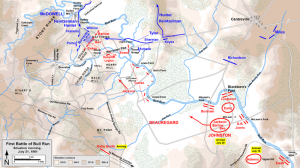
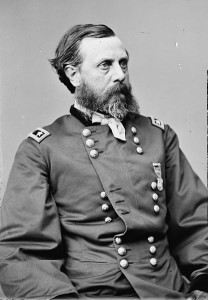
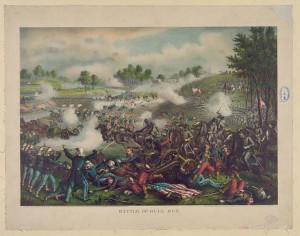
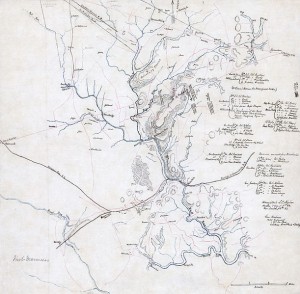
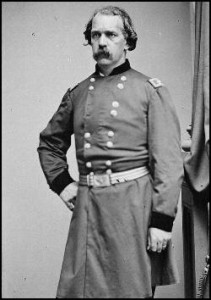
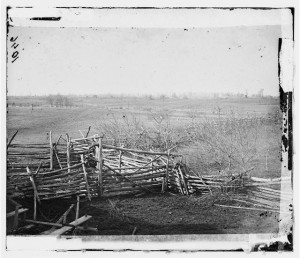
Pingback: Bull Run Brings Out Bears | Blue Gray Review
Pingback: Souvenirs | Blue Gray Review